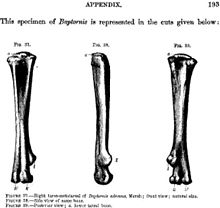
Back Baptornis Catalan Baptornis Esperanto Baptornis Spanish شیرجهمرغ Persian Baptornis French בפטורניס HE Baptornis Italian バプトルニス Japanese Baptornis Dutch Baptornis Portuguese
| Baptornis Temporal range: Late Cretaceous,
| |
|---|---|

| |
| Illustration of a tarsometatarsus, 1880 | |
| Scientific classification | |
| Domain: | Eukaryota |
| Kingdom: | Animalia |
| Phylum: | Chordata |
| Clade: | Dinosauria |
| Clade: | Saurischia |
| Clade: | Theropoda |
| Clade: | Avialae |
| Clade: | †Hesperornithes |
| Family: | †Baptornithidae AOU, 1910 |
| Genus: | †Baptornis Marsh, 1877 |
| Species: | †B. advenus
|
| Binomial name | |
| †Baptornis advenus Marsh, 1877[1]
| |
| Synonyms | |
|
Parascaniornis Lambrecht, 1933 | |
Baptornis ("diving bird") is a genus of flightless, aquatic birds from the Late Cretaceous, some 87-80 million years ago (roughly mid-Coniacian to mid-Campanian faunal stages). The fossils of Baptornis advenus, the type species, were discovered in Kansas, which at its time was mostly covered by the Western Interior Seaway, a shallow shelf sea. It is now known to have also occurred in today's Sweden, where the Turgai Strait joined the ancient North Sea; possibly, it occurred in the entire Holarctic.
Othniel Charles Marsh discovered the first fossils of this bird in the 1870s. This was, alongside the Archaeopteryx, one of the first Mesozoic birds to become known to science.
- ^ Brands, S. (2012)